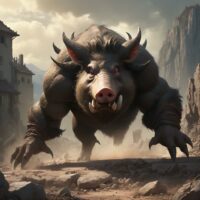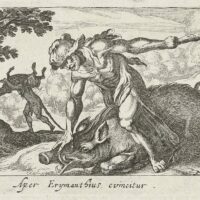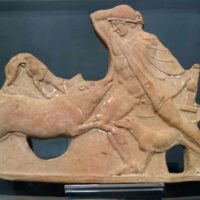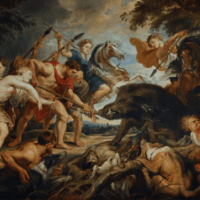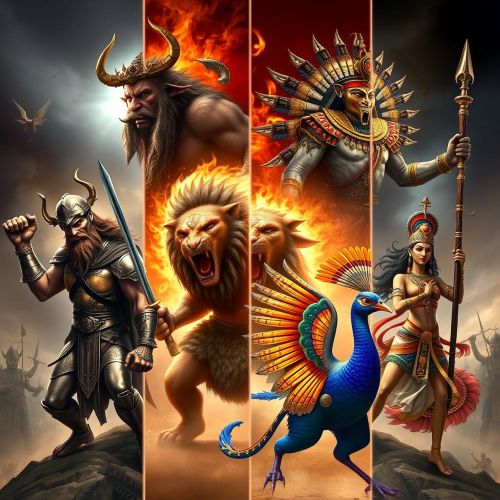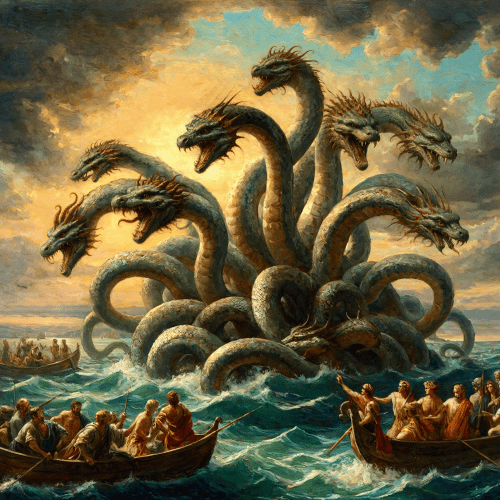Crommyonian Sow : The Greek Terror
Listen
At a glance
| Description | |
|---|---|
| Origin | Greek Mythology |
| Classification | Animals |
| Family Members | Typhon (Father), Echidna (Mother), Nemean Lion, Lernaean Hydra, Chimera, Cerberus (Siblings) |
| Region | Greece |
| Associated With | Strength, Size, Durability |
Crommyonian Sow
Introduction
The Crommyonian Sow, a creature steeped in the rich tapestry of ancient Greek mythology, captivates with its monstrous presence. This wild pig, daunting in its ferocity, posed a formidable challenge to the hero Theseus during his legendary journey from Troezen to Athens. Within the vast realm of Greek myth, brimming with heroic exploits and fantastical beings, the Crommyonian Sow emerges as a striking figure. Its monstrous form and reign of terror over the land of Crommyon add a thrilling dimension to the pantheon of mythical creatures. Among the myriad creatures populating Greek mythology, from serpents spewing fire to hounds with multiple heads, the Crommyonian Sow stands out as a fearsome adversary. Residing near Crommyon, a village nestled on the Isthmus of Corinth, it embodied the primal chaos and danger lurking in the ancient Greek world.
Physical Traits
The Crommyonian Sow, a legendary creature from ancient Greek mythology, was renowned for its colossal size and fearsome appearance. Towering over both humans and ordinary pigs, its sheer magnitude struck terror into the hearts of those who encountered it. With bristling fur, fiery eyes, and razor-sharp tusks, the Sow presented a formidable sight, instilling dread in all who beheld it. Legends spoke of its prodigious strength, capable of tearing apart anything in its path with ease, further solidifying its reputation as a monstrous force to be reckoned with.
Depictions of the Crommyonian Sow varied, with some accounts portraying it as a hulking boar and others emphasizing its sow-like features. Regardless of its gender, the creature possessed traits that evoked awe and fear in equal measure. Its gigantic stature, potentially rivaling that of a large bull or even a rhinoceros, commanded attention and respect. Its razor-sharp tusks, capable of inflicting brutal wounds and tearing through flesh, were dreaded by all who encountered them. Combined with its iron-clad hide, which offered a formidable defense against conventional weaponry, the Sow was a formidable adversary feared by many.
Driven by an insatiable hunger, the Crommyonian Sow was relentless in its pursuit of sustenance, devouring anything unfortunate enough to cross its path. Its unquenchable appetite terrorized the local populace, leaving destruction and chaos in its wake. Despite attempts to subdue or defeat it, the Sow remained a symbol of primal power and untamed wilderness, a reminder of the dangers that lurked in the ancient Greek world.
Family
The Crommyonian Sow, a monstrous entity of ancient Greek mythology, bore lineage that intertwined with some of the most feared creatures of legend. Born from the union of Typhon and Echidna, formidable beings synonymous with chaos and terror, the Sow shared kinship with other notorious monsters like the Nemean Lion, the Lernaean Hydra, and the Chimera. Its origins, steeped in myth and legend, became intertwined with the heroic narrative of Theseus, linking the Sow to tales of valor and peril. Some accounts attribute its creation to Hera, casting it as a punishment upon the land of Crommyon, while others trace its lineage directly to the primal chaos from which it emerged.
Echidna, a half-woman, half-snake creature, and Typhon, a monstrous fire-breathing giant, stood as the fearsome progenitors of the Crommyonian Sow, imbuing it with a legacy of destruction and chaos. This lineage painted a picture of a creature born from the primordial chaos, destined to sow havoc and terror among mortals. However, alternative interpretations of its origins offered a glimpse into a different narrative. According to some versions, the Sow was raised by a cruel woman named Phaea, who nurtured its taste for human flesh, blurring the lines between monstrous beast and the influence of human malevolence.
Other names
The Crommyonian Sow, known by various names throughout ancient lore, offers a multifaceted portrayal in Greek mythology. Among its alternative titles, one stands out: Phaea, a name intertwined with the old woman who nurtured the Sow and whose legacy became synonymous with its monstrous nature. Another epithet, “The Scourge of Crommyon,” paints a vivid picture of the havoc the Sow wrought upon the region, emphasizing its role as a relentless force of destruction. Similarly, “The Iron-Tusked Terror” evokes imagery of the Sow’s deadly tusks and the reign of fear it imposed upon all who encountered it.
These alternative names offer diverse perspectives on the creature, each highlighting different aspects of its character and impact. “Phaea” not only ties the Sow to its caregiver but also emphasizes its swine-like qualities. “The Scourge of Crommyon” and “The Iron-Tusked Terror,” on the other hand, underscore the geographical significance and the menacing nature of the beast, respectively. While “Crommyonian Sow” remains the most recognized appellation, these alternative titles enrich the mythos surrounding this legendary creature, adding depth and nuance to its story.
Powers and Abilities
Within the realm of ancient myth, the Crommyonian Sow loomed as a formidable creature possessing powers and abilities that surpassed mortal comprehension. Its legendary strength was renowned far and wide, capable of unleashing untold devastation upon the countryside with minimal effort. Whispers among storytellers suggested a resilience beyond compare, with tales hinting at its ability to regenerate, rendering it impervious to conventional means of defeat. Such ferocity and invincibility cast a shadow of fear over any who dared to cross its path.
Born from the union of Echidna and Typhon, the Crommyonian Sow inherited a legacy steeped in primal chaos and formidable might. Its very existence was a testament to the terrifying power wielded by its monstrous parents, granting it an unparalleled prowess on the battlefield. Clad in an impenetrable hide and armed with tusks capable of cleaving through armor, it stood as an indomitable force against any who sought to challenge its dominion. Yet, amidst its towering stature and lethal capabilities, the Sow harbored a set of extraordinary abilities that elevated it to the status of a mythical behemoth.
Imbued with immense strength, the Crommyonian Sow could effortlessly overpower even the bravest of warriors, asserting its dominance with every thunderous blow. Tales spoke of its unyielding stamina, painting a picture of a relentless adversary that refused to tire in the face of adversity. Furthermore, rumors circulated of its surprising speed, enabling it to charge with alarming swiftness, catching unsuspecting foes off guard and sealing their fate. These extraordinary traits combined to form an unstoppable force of nature, ensuring that the legend of the Crommyonian Sow would endure for generations to come.
The most famous encounter with the Crommyonian Sow belongs to Theseus, the legendary Athenian hero. On his journey from Troezen to Athens, Theseus, renowned for his strength and courage, confronted the Sow. Accounts differ on the specifics of the fight, but all agree that Theseus emerged victorious, slaying the monstrous beast. This encounter cemented Theseus’ reputation as a champion who rid the land of threats.
Modern Day Influence
The enduring tales of ancient Greek mythology maintain a significant presence in contemporary culture, with the story of the Crommyonian Sow serving as a prime example. This legendary creature has served as a wellspring of inspiration for countless artists, writers, and creators across various mediums. From epic poems to modern novels, its mythic legacy persists through the creative endeavors of individuals worldwide. Its portrayal as a symbol of chaos and primal forces resonates deeply with audiences, bridging the gap between ancient myth and modern sensibilities.
The impact of the Crommyonian Sow on contemporary culture is palpable, often symbolizing the trials and tribulations encountered on the journey toward achieving one’s aspirations. In popular culture, the Sow frequently appears as a metaphorical obstacle to be conquered, echoing the challenges faced by protagonists in their quests for victory. Whether depicted as a towering adversary in video games or as a recurring motif in fantasy literature and role-playing games, the Crommyonian Sow continues to captivate imaginations and inspire creative expression.
Across various platforms and forms of expression, the legacy of the Crommyonian Sow endures, serving as a potent symbol of untamed ferocity and the struggle against formidable odds. Its presence in video games, literature, and figurative language underscores its timeless relevance and the enduring power of myth to captivate and inspire audiences of all ages. As a symbol of primal forces and formidable challenges, the Crommyonian Sow remains a testament to the enduring allure of ancient mythology in shaping contemporary culture.
Related Images
Frequently Asked Questions
What is lorem Ipsum?
I am text block. Click edit button to change this text. Lorem ipsum dolor sit amet, consectetur adipiscing elit. Ut elit tellus, luctus nec ullamcorper mattis, pulvinar dapibus leo.
What is lorem Ipsum?
I am text block. Click edit button to change this text. Lorem ipsum dolor sit amet, consectetur adipiscing elit. Ut elit tellus, luctus nec ullamcorper mattis, pulvinar dapibus leo.
What is lorem Ipsum?
I am text block. Click edit button to change this text. Lorem ipsum dolor sit amet, consectetur adipiscing elit. Ut elit tellus, luctus nec ullamcorper mattis, pulvinar dapibus leo.
What is lorem Ipsum?
I am text block. Click edit button to change this text. Lorem ipsum dolor sit amet, consectetur adipiscing elit. Ut elit tellus, luctus nec ullamcorper mattis, pulvinar dapibus leo.
What is lorem Ipsum?
I am text block. Click edit button to change this text. Lorem ipsum dolor sit amet, consectetur adipiscing elit. Ut elit tellus, luctus nec ullamcorper mattis, pulvinar dapibus leo.

